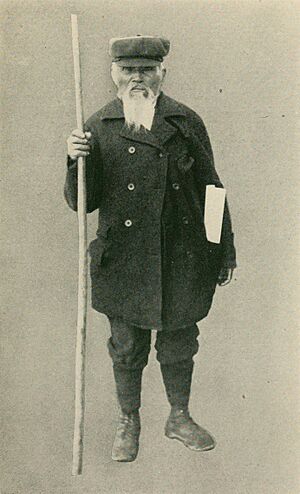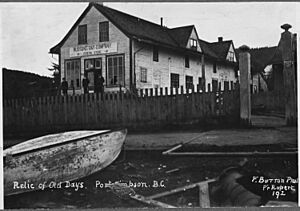Arthur Wellington Clah facts for kids
Arthur Wellington Clah (1831–1916) was a respected First Nations leader from British Columbia, Canada. He worked for the Hudson's Bay Company at a place called Lax Kw'alaams (also known as Port Simpson). Clah was also a hereditary chief of the Tsimshian nation. He was a Methodist missionary and kept a detailed diary for many years. He also shared important information about his culture with researchers.
Contents
Who Was Arthur Wellington Clah?
Arthur Wellington was the English name Clah used. His Tsimshian name was Ła'ax, which is spelled "Clah." He also held another important name, T'amks. This name meant he was a leader of a family group within the Gispaxlo'ots. The Gispaxlo'ots were one of the "Nine Tribes" living in Lax Kw'alaams.
His Early Life and Family
Clah was born in 1831 in a settlement called "Laghco." This was close to where the Hudson's Bay Company built Fort Simpson in 1834. He married Catherine Datacks, who was also known as Dorcas. Catherine belonged to the Laxgibuu (Wolf clan) of the Nisga'a nation. Her aunt was married to W. H. McNeill, who was a chief trader for the Hudson's Bay Company at Fort Simpson. Clah first worked for McNeill as a house servant. Over time, he became a successful trader himself.
Clah and William Duncan
In 1857, a Christian minister named William Duncan arrived in Port Simpson. Clah became Duncan's teacher. He taught Duncan the Tsimshian language. In return, Duncan taught Clah English. They started learning from each other using a trade language called Chinook Jargon.
A Bridge Between Cultures
Clah also helped Duncan connect with the Tsimshian people. Clah became a Christian, but he still took part in traditional Tsimshian ceremonies like the potlatch. There's a famous story about Clah saving Duncan's life. Clah's own tribal chief, Ligeex, was upset about church bells ringing during a special ceremony. Ligeex ordered Duncan to stop, but Clah stepped in and protected Duncan. Later, Chief Ligeex himself became a Christian. This event was written about by Clah in his diary and by his nephew, William Henry Pierce.
Clah's Important Diary
For almost 50 years, from the late 1850s until he passed away, Clah kept a very detailed diary. This diary is now kept at the Wellcome Library in London, England. It gives us an amazing look into what daily life was like in a Tsimshian community in the 1800s.
Sharing Tsimshian Culture
In 1903, a famous anthropologist named Franz Boas wrote to Clah. Boas was interested in learning about Tsimshian culture. Clah eventually passed this request to Henry W. Tate, who was likely his son. This led to the first detailed descriptions of Tsimshian culture being written down.
In 1915, when Clah was very old, he shared more information with another anthropologist, Marius Barbeau. Barbeau was studying how Tsimshian society was organized. Clah's grandson, William Beynon, helped as an interpreter. William Beynon later became a well-known researcher of Indigenous cultures himself. Arthur Wellington Clah passed away in Lax Kw'alaams the next year.



